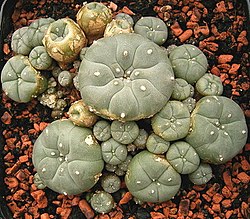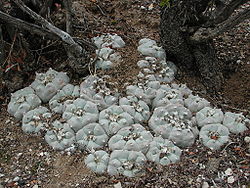Peyote
The peyote is either of two species of the cactus genus Lophophora of plants in the family Cactaceae.
| Peyote | |
|---|---|

| |
| Peyote in the wild | |
| Conservation status | |
| Scientific classification | |
| Kingdom: | Plantae |
| Order: | Caryophyllales |
| Family: | Cactaceae |
| Genus: | Lophophora |
| Species: | L. williamsii
|
| Binomial name | |
| Lophophora williamsii | |
| Synonyms | |
|
Echinocactus williamsii Lemaire ex Salm-Dyck | |
The most common plant, L. williamsii, grow in North America, mostly in Mexico,[2] can be found in the Chihuahuan desert of southern Texas and northern Mexico. The size is about eight centimeters (three inches) wide and five centimeters (two inches) tall. It is mostly blue green in color, with pink to white flowers, growing in groups among scrub, in areas with limestone soil. L. diffusa grows only in a small area in central Mexico, the color is yellow green, with white to yellow flowers.
Peyote has hallucinogenic effects, made by at least 28 different alkaloids, mostly mescaline. In many countries it is illegal to sell, use or posses both dried plant-material and living plants, but some places also give an exception from the law when used in religious rituals, such as by The Native American Church where it is used in a similar way as some Native American tribes, that likely have used peyote for at least 5,500 years. in their rituals.
Peyote Media
References
- ↑ "Lophophora williamsii". IUCN Red List of Threatened Species. IUCN. 2017. 2017. Retrieved 12 April 2018.
- ↑ http://www.britannica.com/EBchecked/topic/454720/peyote










